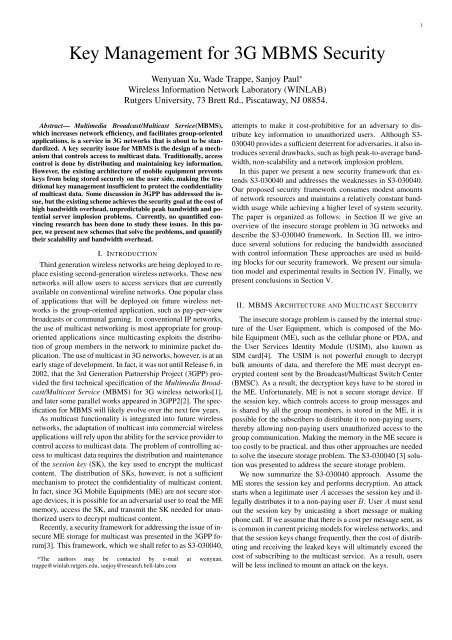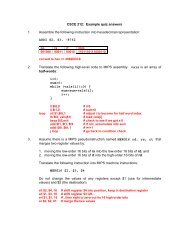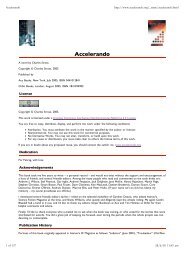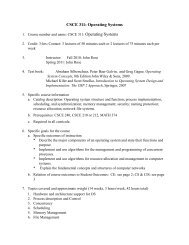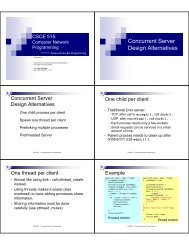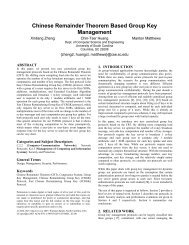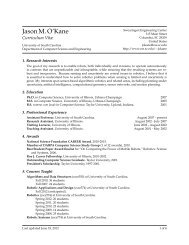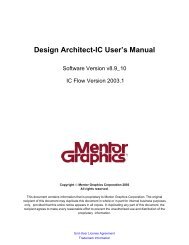Key Management for 3G MBMS Security
Key Management for 3G MBMS Security
Key Management for 3G MBMS Security
Create successful ePaper yourself
Turn your PDF publications into a flip-book with our unique Google optimized e-Paper software.
<strong>Key</strong> <strong>Management</strong> <strong>for</strong> <strong>3G</strong> <strong>MBMS</strong> <strong>Security</strong><br />
Wenyuan Xu, Wade Trappe, Sanjoy Paul ∗<br />
Wireless In<strong>for</strong>mation Network Laboratory (WINLAB)<br />
Rutgers University, 73 Brett Rd., Piscataway, NJ 08854.<br />
Abstract— Multimedia Broadcast/Multicast Service(<strong>MBMS</strong>),<br />
which increases network efficiency, and facilitates group-oriented<br />
applications, is a service in <strong>3G</strong> networks that is about to be standardized.<br />
A key security issue <strong>for</strong> <strong>MBMS</strong> is the design of a mechanism<br />
that controls access to multicast data. Traditionally, access<br />
control is done by distributing and maintaining key in<strong>for</strong>mation.<br />
However, the existing architecture of mobile equipment prevents<br />
keys from being stored securely on the user side, making the traditional<br />
key management insufficient to protect the confidentiality<br />
of multicast data. Some discussion in <strong>3G</strong>PP has addressed the issue,<br />
but the existing scheme achieves the security goal at the cost of<br />
high bandwidth overhead, unpredictable peak bandwidth and potential<br />
server implosion problems. Currently, no quantified convincing<br />
research has been done to study these issues. In this paper,<br />
we present new schemes that solve the problems, and quantify<br />
their scalability and bandwidth overhead.<br />
I. INTRODUCTION<br />
Third generation wireless networks are being deployed to replace<br />
existing second-generation wireless networks. These new<br />
networks will allow users to access services that are currently<br />
available on conventional wireline networks. One popular class<br />
of applications that will be deployed on future wireless networks<br />
is the group-oriented application, such as pay-per-view<br />
broadcasts or communal gaming. In conventional IP networks,<br />
the use of multicast networking is most appropriate <strong>for</strong> grouporiented<br />
applications since multicasting exploits the distribution<br />
of group members in the network to minimize packet duplication.<br />
The use of multicast in <strong>3G</strong> networks, however, is at an<br />
early stage of development. In fact, it was not until Release 6, in<br />
2002, that the 3rd Generation Partnership Project (<strong>3G</strong>PP) provided<br />
the first technical specification of the Multimedia Broadcast/Multicast<br />
Service (<strong>MBMS</strong>) <strong>for</strong> <strong>3G</strong> wireless networks[1],<br />
and later some parallel works appeared in <strong>3G</strong>PP2[2]. The specification<br />
<strong>for</strong> <strong>MBMS</strong> will likely evolve over the next few years.<br />
As multicast functionality is integrated into future wireless<br />
networks, the adaptation of multicast into commercial wireless<br />
applications will rely upon the ability <strong>for</strong> the service provider to<br />
control access to multicast data. The problem of controlling access<br />
to multicast data requires the distribution and maintenance<br />
of the session key (SK), the key used to encrypt the multicast<br />
content. The distribution of SKs, however, is not a sufficient<br />
mechanism to protect the confidentiality of multicast content.<br />
In fact, since <strong>3G</strong> Mobile Equipments (ME) are not secure storage<br />
devices, it is possible <strong>for</strong> an adversarial user to read the ME<br />
memory, access the SK, and transmit the SK needed <strong>for</strong> unauthorized<br />
users to decrypt multicast content.<br />
Recently, a security framework <strong>for</strong> addressing the issue of insecure<br />
ME storage <strong>for</strong> multicast was presented in the <strong>3G</strong>PP <strong>for</strong>um[3].<br />
This framework, which we shall refer to as S3-030040,<br />
*The authors may be contacted by e-mail at wenyuan,<br />
trappe@winlab.rutgers.edu, sanjoy@research.bell-labs.com<br />
attempts to make it cost-prohibitive <strong>for</strong> an adversary to distribute<br />
key in<strong>for</strong>mation to unauthorized users. Although S3-<br />
030040 provides a sufficient deterrent <strong>for</strong> adversaries, it also introduces<br />
several drawbacks, such as high peak-to-average bandwidth,<br />
non-scalability and a network implosion problem.<br />
In this paper we present a new security framework that extends<br />
S3-030040 and addresses the weaknesses in S3-030040.<br />
Our proposed security framework consumes modest amounts<br />
of network resources and maintains a relatively constant bandwidth<br />
usage while achieving a higher level of system security.<br />
The paper is organized as follows: in Section II we give an<br />
overview of the insecure storage problem in <strong>3G</strong> networks and<br />
describe the S3-030040 framework. In Section III, we introduce<br />
several solutions <strong>for</strong> reducing the bandwidth associated<br />
with control in<strong>for</strong>mation These approaches are used as building<br />
blocks <strong>for</strong> our security framework. We present our simulation<br />
model and experimental results in Section IV. Finally, we<br />
present conclusions in Section V.<br />
II. <strong>MBMS</strong> ARCHITECTURE AND MULTICAST SECURITY<br />
The insecure storage problem is caused by the internal structure<br />
of the User Equipment, which is composed of the Mobile<br />
Equipment (ME), such as the cellular phone or PDA, and<br />
the User Services Identity Module (USIM), also known as<br />
SIM card[4]. The USIM is not powerful enough to decrypt<br />
bulk amounts of data, and there<strong>for</strong>e the ME must decrypt encrypted<br />
content sent by the Broadcast/Multicast Switch Center<br />
(BMSC). As a result, the decryption keys have to be stored in<br />
the ME. Un<strong>for</strong>tunately, ME is not a secure storage device. If<br />
the session key, which controls access to group messages and<br />
is shared by all the group members, is stored in the ME, it is<br />
possible <strong>for</strong> the subscribers to distribute it to non-paying users,<br />
thereby allowing non-paying users unauthorized access to the<br />
group communication. Making the memory in the ME secure is<br />
too costly to be practical, and thus other approaches are needed<br />
to solve the insecure storage problem. The S3-030040 [3] solution<br />
was presented to address the secure storage problem.<br />
We now summarize the S3-030040 approach. Assume the<br />
ME stores the session key and per<strong>for</strong>ms decryption. An attack<br />
starts when a legitimate user A accesses the session key and illegally<br />
distributes it to a non-paying user B. User A must send<br />
out the session key by unicasting a short message or making<br />
phone call. If we assume that there is a cost per message sent, as<br />
is common in current pricing models <strong>for</strong> wireless networks, and<br />
that the session keys change frequently, then the cost of distributing<br />
and receiving the leaked keys will ultimately exceed the<br />
cost of subscribing to the multicast service. As a result, users<br />
will be less inclined to mount an attack on the keys.<br />
1
SK || SK_RAND<br />
|| BAK_ID<br />
||BAK_Expire<br />
BAK || BAK_ID<br />
|| BAK_Expire<br />
BAK || BAK_ID<br />
|| BAK_Expire<br />
Subscription<br />
Manager<br />
BMSC<br />
Content<br />
Encryption<br />
7<br />
SK<br />
Manager<br />
BAK<br />
Generator<br />
BAK<br />
Distributor<br />
Subscription in<strong>for</strong>mation<br />
2<br />
1<br />
1<br />
6<br />
CipherText || SK_RAND || BAK_ID || BAK_Expire<br />
3<br />
UE<br />
SK_RAND || BAK_ID SK<br />
4<br />
ME USIM<br />
5<br />
BAK_ID || USIM_ID<br />
E(BAK)<br />
DATA<br />
Data Request<br />
Comment<br />
1: BAK Generator generates a new BAK and sends it to SK manager and BAK distributor.<br />
2: SK manager randomly selects a number SK_RAND, gets SK = f (SK_RAND, BAK) and sends<br />
SK_RAND, SK, BAK_ID, and BAK_Expire to Content Encryption (CE).<br />
3: CE encrypts the content using SK, attaches SK_RAND, BAK_ID, and BAK_Expire as plaintext to the<br />
packet. And it sends out the packet to ME.<br />
4: If no new SK is used, ME just decrypt the packet. Otherwise, ME sends a request containing<br />
SK_RAND and BAK_ID to the USIM.<br />
5: If USIM knows the BAK indexed by BAK_ID, it calculates SK = f (SK_RAND, BAK) and sends SK<br />
to ME. Otherwise, step 6, 7 and 8 are needed be<strong>for</strong>e USIM can send SK to ME.<br />
6: USIM sends a BAK request including its identification to BAK distributor.<br />
7: BAK Distributor checks the USIM legality with Subscription Manager (SM), and receives the<br />
USIM’s Registration <strong>Key</strong> (RK) from SM, which may have been built into USIM card at the factory.<br />
8: BAK distributor sends out the encrypted BAK to the USIM using Temporary keys derived from RK.<br />
Fig. 1. The S3-030040 <strong>MBMS</strong> <strong>Security</strong> Framework.<br />
In order to change the session keys frequently, while maintaining<br />
a reasonable amount of communication overhead, a key<br />
hierarchy was proposed in S3-030040. First, there are registration<br />
keys (RK), temporary keys (T K) and broadcast access<br />
keys (BAK), which are known only to USIM and BMSC<br />
but not to the ME. Second, the Session <strong>Key</strong> (SK), which is<br />
also known as the Short-Term <strong>Key</strong>, needs to be changed at a<br />
high rate and has a shorter life span than the BAK. To facilitate<br />
the distribution of the keying material, the S3-030040<br />
security framework is composed of the BAK Distributor, BAK<br />
Generator, Short-term <strong>Key</strong> Manager, Content Encryption entity<br />
and Subscription Manager. All entities except the Subscription<br />
Manager are located in the BMSC. The dataflow among these<br />
entities is shown in Fig. 1.<br />
Note that ME doesn’t contain the current BAKj but only has<br />
the current SKi. In order to attack, every SKi has to be sent out<br />
and the cost is determined by the SK change rate and price per<br />
transmission. There<strong>for</strong>e, by adjusting the SK change rate the<br />
security goal can be easily achieved. Further, as Fig. 2 shows,<br />
only when the user knows both SK RANDi and BAKj can<br />
he/she get SKi and decrypt the ciphertext.<br />
The above framework solves the insecure storage problem,<br />
but introduces the following drawbacks:<br />
1. The SK RAND is 32 bits and the SK is 128bits. The<br />
key space, and hence security, has decreased from 2 128 to 2 32 .<br />
2. If the SK RAND attached in each packet is compromised,<br />
even if the payload itself is correctly transmitted, a retransmission<br />
of the whole package is needed.<br />
3. Transmitting SK RAND introduces additional communication<br />
overhead.<br />
4. When a new BAK is used, each USIM sends a BAK request<br />
to BAK Distributor leading to a BAK implosion problem.<br />
In addition, the point-to-point sending of BAKs generated as a<br />
result of these BAK requests significantly increases bandwidth<br />
usage.<br />
5. The point-to-point BAK update scheme requires the server<br />
8<br />
tSKi<br />
S_R1 S_R2 S_R3 S_R4 S_R5 S_R6 S_R7 S_R8<br />
SK1 SK2 SK3 SK4 SK5 SK6 SK7 SK8<br />
BAK1 BAK2 …<br />
tBAKj<br />
Fig. 2. The key hierarchy. S Ri denotes SK RANDi. tSK i is<br />
the valid time slot <strong>for</strong> SKi. tBAK j is the valid time slot <strong>for</strong> BAKj,<br />
where tSK i ≪ tBAK j .<br />
to process each BAK request individually, encrypt the new<br />
BAK <strong>for</strong> each client and transmit it to each client. This is<br />
clearly not scalable.<br />
…<br />
…<br />
Time<br />
III. AN IMPROVED <strong>MBMS</strong> SECURE FRAMEWORK<br />
A. SK Generation Improvement<br />
The first three drawbacks mentioned above are a consequence<br />
of the overhead associated with sending SK RAND<br />
with the message over the wireless channel. In order to reduce<br />
this overhead, we propose a new method <strong>for</strong> generating<br />
the session keys that does not involve sending SK RAND.<br />
Instead of updating SK by sending out SK RAND, we send<br />
out an ID to indicate which SK is being used. Further, each<br />
time a new SK is used, the USIM generates the SK locally<br />
by employing a function chain consisting of cryptographic oneway<br />
functions. As a result, if we use 8 bits to transmit the ID<br />
instead of a 32-bit SK RAND, we can decrease communication<br />
cost in each packet by 24 bits while increase the key<br />
space to 2 128 from 2 32 . The SK chain can be generated by:<br />
SK0 = f(SK SEED, BAK), SK1 = f(SK0, BAK), . . .,<br />
SKi+1 = f(SKi, BAK).<br />
Here f is a suitable cryptographic one-way function, such<br />
as SHA-1 or MD5. The one-way property guarantees that an<br />
adversary cannot calculate BAK, even if he/she knows SKi,<br />
SKi+1 and f. It is desirable that f is computationally efficient<br />
since the USIM has limited computational power.<br />
By generating the chain of SKs locally, the success of generating<br />
a new SK is no longer as closely related to the in<strong>for</strong>mation<br />
sent in each packet as in the S3-030040 method. Instead, all<br />
that is needed is the ID, which is usually sequential and can be<br />
inferred even if the ID portion of the message is corrupted. This<br />
fact provides an additional advantage over S3-030040 <strong>for</strong> cases<br />
in which a rekeying instance is missed by a user. Rather than requesting<br />
retransmission of prior rekeying packets, the user can<br />
locally reconstruct missed session keys in the key chain. Finally,<br />
since the function f can be the same as that proposed in<br />
S3-030040, the improved SK-updating scheme has at least the<br />
same level of system security as that of S3-030040 method, but<br />
at the cost of lower bandwidth usage.<br />
B. BAK Distribution Improvement<br />
We now describe improved methods <strong>for</strong> distributing the<br />
BAK. We begin by discussing the issue of BAK Update Initiation.<br />
When a new BAK is used, each USIM will simultaneously<br />
send a BAK request to BAK Distributor. There is no<br />
mechanism to coordinate BAK requests. If the group size is<br />
big, then this will cause a serious BAK implosion problem.<br />
2
<strong>Key</strong>s stored in U1<br />
BAK<br />
K0 K1<br />
K K K K<br />
00 01 10 11<br />
KEK key Node<br />
K000 K001 K010 K011 K100 K101 K110 K111<br />
U1 U2 U3 U4 U5 U6 U7 U8<br />
Fig. 3. The BAK key tree with eight subscribers.<br />
Leaf keys<br />
Subscribers<br />
We observe that the server precisely knows when a new BAK<br />
is used and as a result, also knows that it will receive a large<br />
number of BAK request messages. Based on this knowledge,<br />
the server can proactively push the new BAK to each subscriber.<br />
As a result of pushing instead of pulling, the implosion<br />
problem is eliminated. One advantage of this scheme is that it<br />
allows a fine-grained billing: instead of billing by number of<br />
BAKs used as in S3-030040, we can now bill by the duration a<br />
user participates in a multicast service.<br />
Next, we discuss the issue of BAK Distribution. To maintain<br />
a high security level, the BAK needs to be changed and<br />
distributed to each subscriber securely whenever users join or<br />
leave the group. If we simply change the pull scheme into a<br />
push scheme, then the communication cost and BAK encryption<br />
cost will be proportional to the multicast group size n. This<br />
is inefficient <strong>for</strong> large groups.<br />
In order to obtain a more scalable solution to BAK distribution,<br />
we propose to use a key tree [5][6] consisting of intermediate<br />
keys known as <strong>Key</strong> Encryption <strong>Key</strong>s (KEK) and a root<br />
key, BAK. These KEKs are arranged in a hierarchy and assist<br />
in updating the root key BAK in subgroups. For example, Fig.<br />
3 depicts a binary tree with 8 subscribers U1 to U8, who have<br />
already joined the group. When some users join the group, the<br />
old BAK is used to encrypt and distribute the new BAK. The<br />
cost <strong>for</strong> this is only 1 unit time <strong>for</strong> encryption and 1 packet <strong>for</strong><br />
communication.<br />
When a user leaves, only the KEKs known to the leaving<br />
user need to be changed. In this case, the lower level old KEK<br />
is used to encrypt the higher level KEK. For example, if U1<br />
leaves, then BAK, K0 and K00 should be changed. We use<br />
{BAK ′ }K1 to represent the message with content BAK′ encrypted<br />
by K1. In order to update all the KEKs the following<br />
messages need to be sent out by the BAK Manager (denoted by<br />
s in the following lines):<br />
s → {U2} : {K ′ 00}K001, {K ′ 0}K ′ 00<br />
s → {U3, U4} : {K ′ 0}K01<br />
s → {U2, U3, U4} : {BAK ′ }K 0 ′<br />
s → {U5, U6, U7, U8} : {BAK ′ }K1<br />
The communication cost and BAK encryption cost of using<br />
the key-tree updating method is at most O(log(n)) in the leave<br />
case. The cost of BAK update in the case of join, and in the<br />
case of join/no-leave is O(1).<br />
The key tree efficiently updates the BAK <strong>for</strong> each join/leave,<br />
but when the frequency of the user join/leave events is high,<br />
the BAKs still have to be changed frequently. As a result, the<br />
Link 1 Link2<br />
B1 N1 N2<br />
Queue length (l)<br />
Service rate (u)<br />
Wired link<br />
Wireless link<br />
Network<br />
Bottleneck bandwidth<br />
Loss rate<br />
Delay<br />
Fig. 4. The simulation topology.<br />
U1<br />
U2<br />
Ui<br />
Users’ inter arrival time<br />
Duration time<br />
bandwidth used in key update can still be considerably large.<br />
This is the trade off between security and communication cost.<br />
If we only want the same security level in S3-030040 proposal,<br />
we need only update the BAK periodically no matter whether<br />
the subscribers have changed or not. But if we want higher security<br />
levels, we need to change the BAK whenever users join<br />
or leave the group. To achieve optimal tradeoff, we can batch<br />
join/leave events that occur during a suitably chosen window<br />
of time into one rekeying event instead of handling them separately.<br />
Finally, to further achieve communication efficiency, we<br />
can map the key tree to the physical location of the user, and as<br />
a result the key updating messages will be transmitted using as<br />
few links as possible[7].<br />
IV. SIMULATION<br />
We now present simulations to validate the claimed improvements<br />
provided by the proposed key distribution scheme. We<br />
begin by discussing the simulation model, then describe the<br />
models used <strong>for</strong> the data traffic and the membership dynamics,<br />
and finally present the simulation results.<br />
A. Simulation Model<br />
Our simulations were per<strong>for</strong>med in NS-2. The simulation<br />
model consists of three separate components, as depicted in<br />
Fig. 4. The first entity is the BMSC, depicted as node<br />
B1. The parameters <strong>for</strong> the BMSC include the length of the<br />
join/leave request queue, and the service time <strong>for</strong> these requests.<br />
The Network component consists of two internal nodes<br />
N1 and N2, as well as Link2. The nodes N1 and N2 correspond<br />
to the endpoint nodes of the bottleneck link Link2.<br />
Only two nodes are used to represent the Network since we<br />
are primarily concerned with capturing the bottleneck effect<br />
in the Network. As an example, node N1 could correspond<br />
to the Gateway GPRS(General Packet Radio Service) Supporting<br />
Node(GGSN), node N2 the Serving GPRS Support Node<br />
(SGSN), and Link2 the bottleneck link between the GGSN and<br />
the SGSN. The parameters associated with Link2 are the link<br />
bandwidth, link delay and loss rate. Finally, in the third part,<br />
we represent the mobile users U1, U2 . . . Ui. The mobile users<br />
are characterized by the rate at which new users join the multicast<br />
group (referred to as arrival rate), and the duration of their<br />
service.<br />
Our simulation models the join/leave patterns <strong>for</strong> the mobile<br />
users under different service scenarios including a chatting service<br />
and a multimedia service.We used UDP to transmit the data<br />
and control packets, and we developed an <strong>MBMS</strong> application<br />
3
on top of UDP. The <strong>MBMS</strong> application emulates the functions<br />
belonging to the Content Encryption Entity, the SK-Manager,<br />
the BAK Distributor, the BAK Generator and the Subscription<br />
Manager. By designing the model in this manner, we have kept<br />
the simulation simple enough to control while also maintaining<br />
enough complexity to capture realistic scenarios.<br />
B. Traffic Model and User Join/Leave Model<br />
We are not aware of any existing research on data traffic <strong>for</strong><br />
<strong>3G</strong> multicast. On the other hand, IP multicast is a mature re-<br />
search field and there is a significant body of research on IP<br />
multicast traffic measurement and the join/leave behavior of IP<br />
multicast group members[8]. For the purpose of this paper, we<br />
assume that the characteristics of <strong>3G</strong> multicast applications are<br />
similar to IP multicast applications, and there<strong>for</strong>e we will use<br />
IP multicast traffic patterns in our <strong>3G</strong> experiments.<br />
The majority of IP multicast traffic depends on only a small<br />
set of “special” events, such as a single Internet-wide multicast<br />
of a seminar. There<strong>for</strong>e, in our simulations, we only considered<br />
one multicast service running on the <strong>3G</strong> network, and studied<br />
two different application scenarios. First, we simulated a multicast<br />
movie session, involving multicasting of video and audio<br />
data, lasting <strong>for</strong> 4000 seconds. Second we simulated a chatsession,<br />
involving textual data only, lasting <strong>for</strong> half a day.<br />
1) Movie Multicast Session: The multicast movie session<br />
is a pay-per-view service in which the user is charged <strong>for</strong> the<br />
amount of the movie he watches. Since advanced compression<br />
codecs will most likely be used on <strong>3G</strong> and beyond cellular<br />
systems, we chose to use MPEG-4 and H.263 video traces,<br />
and statistical data of Start Wars IV, Jurassic Park I and Silence<br />
of the Lambs from [9]. Frame period of t = 40ms, peruser<br />
bandwidth of 50kbps - 80kbps, and a mean frame size of<br />
x = 0.5KBytes were used. Using the frame size histograms<br />
presented in [9], the frame size of Star Wars IV can be adequately<br />
modeled using a lognormal distribution. We there<strong>for</strong>e<br />
generated N = 100, 000 frames with a frame size according to<br />
the lognormal distribution with the mean µ = 0.27, µ = 0.77<br />
and µ = 0.53 KBytes respectively <strong>for</strong> each of the three movies.<br />
The inter-arrival time and the membership duration characterize<br />
the group join/leave behavior. According to the model<br />
[8], the user join/leave behavior may be modeled as a Poisson<br />
Process. The inter-arrival time was modeled using an exponential<br />
distribution with mean of 1.5s <strong>for</strong> the first 150 seconds of<br />
the movie, and an exponential distribution with mean of 150s<br />
<strong>for</strong> the remainder of the movie. Using real measurements of the<br />
UCB seminar in[8], the mean membership duration was chosen<br />
to be 46 minutes. In summary, our join/leave process exhibits a<br />
larger fraction of joins near the program’s scheduled start, and<br />
fewer joins after the first few minutes.<br />
2) Chat Session: The traffic of a text-only chat session is<br />
one of the least investigated types of traffic. In order to model<br />
it, we use the exponential distribution to represent inter-packet<br />
arrival times, and assume the mean inter-packet arrival time is<br />
related to the group size. Additionally, we assume the mean<br />
inter-packet arrival time is much larger than <strong>for</strong> a movie since<br />
humans are relatively slow machines <strong>for</strong> generating traffic. The<br />
packet size is usually short since people tend to send simple<br />
message like ”hello”. To model the user join/leave behavior,<br />
o mode<br />
or mode<br />
85<br />
80<br />
75<br />
70<br />
65<br />
60<br />
55<br />
50<br />
85<br />
80<br />
75<br />
70<br />
65<br />
60<br />
55<br />
bandwidth (kb/s)<br />
observed data<br />
movie data only<br />
observed data<br />
movie data only<br />
800<br />
700<br />
600<br />
500<br />
400<br />
300<br />
200<br />
100<br />
0<br />
800<br />
700<br />
600<br />
500<br />
400<br />
300<br />
200<br />
100<br />
queue lengh and group size<br />
group size<br />
queue length<br />
group size<br />
queue length<br />
50<br />
0 500 1000 1500 2000 2500 3000 3500 4000<br />
0<br />
0 500 1000 1500 2000 2500 3000 3500 4000<br />
time (second)<br />
time (second)<br />
Fig. 5. The bandwidth and queue length result in the two pulling<br />
modes.<br />
we chose to characterize a chat session using the long session<br />
model described in [8]. This was done since chat services typically<br />
run <strong>for</strong> periods on the order of a day. As a result, the session<br />
duration is modeled as a Zipf Random Variable [8], while<br />
the user inter-arrival time is an exponential Random Variable.<br />
We chose to simulate two scenarios: a weekday and a weeknight<br />
chat session. A weekday chat session was simulated with<br />
a mean inter-arrival time of 22.1 seconds, and mean duration<br />
of 5 hours. These values were taken from the measurements<br />
of the STS-63 session that were published in [8]. A weeknight<br />
chat session was simulated with a mean inter-arrival time of 4<br />
minutes and a duration of 6 hours.<br />
C. Simulation Results<br />
We ran our simulations <strong>for</strong> six different modes of operation:<br />
1. (o mode): o mode corresponds to the original S3-030040<br />
mode. In this mode, SKs are generated from SK RAND.<br />
Users send BAK requests to the server whenever they need a<br />
new BAK. The server distributes the requested BAKs using<br />
unicast. Each transmission is encrypted with each user’s TK.<br />
2. (or mode): In or (original randomized) mode, users<br />
still pull BAKs from the server and calculate SKs from<br />
SK RAND. However, to partially alleviate the BAK implosion<br />
problem, users send out their BAK requests after a<br />
random amount of time (uni<strong>for</strong>m(0, 1)sec) following the moment<br />
they detect they need a new BAK.<br />
3. (npr mode): npr denotes a new point-to-point real-time<br />
mode. The SKs are generated using a one-way function. The<br />
server pushes the new BAKs to each user via unicast whenever<br />
the server receives a join/leave request.<br />
4. (npc mode): npc mode is similar to npr mode, except that<br />
the server updates the BAK after a threshold amount of time<br />
after a new BAK is used. In our simulation, the time threshold<br />
is set to be the same as the BAK expiration time in o mode.<br />
5. (ntr mode): ntr denotes the new tree-based real-time<br />
mode. In this mode, the server pushes the new BAKs to each<br />
user when a new join/leave request is received. The server distributes<br />
the BAKs using a tree-based key update scheme.<br />
6. (ntc mode): ntc mode is almost the same as ntr mode.<br />
The only difference is that the BAK is updated after it is used<br />
<strong>for</strong> a threshold amount of time.<br />
4
85<br />
80<br />
75<br />
70<br />
65<br />
60<br />
55<br />
50<br />
85<br />
80<br />
75<br />
70<br />
65<br />
60<br />
55<br />
50<br />
npc mode<br />
observed data<br />
movie data only<br />
ntc mode<br />
observed data<br />
movie data only<br />
0 500 1000 1500 2000 2500 3000 3500 4000<br />
time (second)<br />
250<br />
200<br />
150<br />
100<br />
50<br />
85<br />
80<br />
75<br />
70<br />
65<br />
60<br />
55<br />
50<br />
npr mode<br />
observed data<br />
movie data only<br />
ntr mode<br />
observed data<br />
movie data only<br />
0 500 1000 1500 2000 2500 3000 3500 4000<br />
time (second)<br />
Fig. 6. The bandwidth (kb/s) in the four pushing modes.<br />
Fig. 5 is the simulation results <strong>for</strong> the queue and bandwidth<br />
data in the first 2 pulling modes. The input traffic pattern is the<br />
low resolution Star War IV. From Fig. 5, we note that there are<br />
two problems in o mode: (1) the queue length is proportional<br />
to the group size at the moment a new BAK is used in o mode,<br />
and (2)the peak bandwidth is very high. The or mode led to<br />
much shorter queues than in o mode. This implies that sending<br />
out the BAK request after a random amount of time does alleviate<br />
the BAK implosion problem. But, it does not help the<br />
high peak bandwidth problem.<br />
Fig. 6 presents the simulation results <strong>for</strong> the bandwidth used<br />
in the four pushing modes. The input traffic pattern is the same<br />
as in Fig. 5. For all four modes, the queue length is not an issue,<br />
so we do not present the queue length in the figure. For pointto-point<br />
server pushing BAK modes (npc, npr), the peak bandwidth<br />
is still a problem. This is especially true in npr where too<br />
much bandwidth is devoted to update the new BAK during a<br />
change in the group membership. The peak bandwidth of ntr<br />
and ntc is the lowest.<br />
To test the scalability of the different modes, we ran the simulations<br />
<strong>for</strong> different group sizes ranging from 42 to 114, 000.<br />
A group size of 114, 000 can occur when a carrier with a million<br />
users has 1% of its users subscribe to a popular event, like the<br />
Olympics. The first plot in Fig.7 shows the average bandwidth<br />
usage over the entire movie. We observe that ntc has the best<br />
scalability in terms of average bandwidth. But when group size<br />
is less than 11, 400, the benefit of ntc <strong>for</strong> average bandwidth<br />
reduction is less pronounced. However, average bandwidth,<br />
which is partially determined by the BAK update rate, is not<br />
enough <strong>for</strong> judging scalability. The peak bandwidth is more significant<br />
as traffic bursts are problematic <strong>for</strong> networks. The second<br />
plot in Fig.7 depicts the peak bandwidth used, which confirms<br />
that ntc is the most scalable mode. As the group size becomes<br />
larger than 5000, the maximum bandwidth overhead of<br />
ntc scheme is 96% less than that introduced by the S3-030040<br />
scheme. Similar results were observed <strong>for</strong> the chat session.<br />
V. CONCLUSION<br />
Be<strong>for</strong>e <strong>MBMS</strong> can be successfully deployed, the problem of<br />
controlling access to multicast data has to be solved. The insecure<br />
storage problem of the existing ME reduces the effective-<br />
...<br />
11296<br />
6056<br />
2086<br />
1789<br />
2800<br />
2491<br />
Fig. 7. The bandwidth <strong>for</strong> different group sizes and modes.<br />
ness of traditional multicast key distribution mechanisms. One<br />
approach to solve this is to change the SK frequently enough to<br />
make an attack too costly to per<strong>for</strong>m. Previous methods using<br />
this strategy have significantly increased load on the network.<br />
We have presented techniques that eliminate the BAK implosion<br />
problem and also reduce the bandwidth need to per<strong>for</strong>m<br />
key management. We presented simulation results <strong>for</strong> a serverbased<br />
multicast video service to show that from the system per<strong>for</strong>mance<br />
and scalability point-of-view, the best security framework<br />
is the one where the servers push the new BAK to group<br />
of users based on a key-tree structure, and use time thresholding<br />
together with the join/leave request as the indicator of when<br />
to update a new BAK. On the other hand, if the simplicity of<br />
implementation is the major concern and if the group size is<br />
always small, it might be better to implement a server-pushing<br />
point-to-point BAK update scheme, since the benefits are lesspronounced<br />
when the group size is less than 760 users.<br />
REFERENCES<br />
[1] 3rd Generation Partnership Project, “Multimedia broadcast/multicast service;<br />
release 6,” Tech. Rep. TS 22.146 V6.1.0, Sep. 2002.<br />
[2] P. Agrawal, M. C. Chuah, and J. Zander, “Multimedia multicast/broadcast<br />
services in <strong>3G</strong>/4G networks,” Communications Magazine, IEEE, vol. 42,<br />
no. 2, 2004.<br />
[3] P. Hawkes and R. Subramanian, “Explanation of BAK-based key management,”<br />
Tech. Rep. <strong>3G</strong>PP S3-030040, QUACOMM, France, Fre. 2003.<br />
[4] 3rd Generation Partnership Project, “Network architecture; release 5,”<br />
Tech. Rep. <strong>3G</strong>PP TS 23.002 V5.9.0, Dec. 2002.<br />
[5] D. Wallner, E. Harder, and R. Agee, “<strong>Key</strong> management <strong>for</strong> multicast:<br />
Issues and architectures,” RFC 2627, June 1999.<br />
[6] C. K. Wong, M.Gouda, and S.S. Lam, “Secure group communications<br />
using key graphs,” IEEE/ACM Transactions on Networking, vol. 8, no. 1,<br />
pp. 16–31, February 2000.<br />
[7] Y. Sun, W. Trappe, and K.J.R. Liu, “An efficient key management scheme<br />
<strong>for</strong> secure wireless multicast,” in IEEE Int. Conference on Communications,<br />
2002, pp. 1236–1240.<br />
[8] K. Almeroth and M. Ammar, “Collecting and modeling of the join/leave<br />
behavior of multicast group members in the mbone,” High Per<strong>for</strong>mance<br />
Distributed Computing Focus Workshop (HPDC), August 1996.<br />
[9] F.H.P. Fitzek and M. Reisslein, “MPEG-4 and H.263 video traces <strong>for</strong><br />
network per<strong>for</strong>mance evaluation,” IEEE Network, vol. 15, no. 6, pp. 40–<br />
54, November/December 2001.<br />
[10] 3rd Generation Partnership Project, “General packet radio service<br />
(GPRS); service description; release 5;,” Tech. Rep. TS 23.060 V5.4.0,<br />
Dec. 2002.<br />
5


